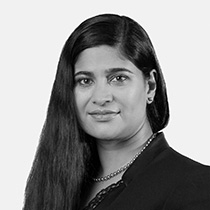The war in Ukraine dominated world events during the first quarter of 2022
(Q1-22). This is first and foremost a human tragedy, and Russia’s actions should be condemned in the strongest possible terms. The invasion was not broadly anticipated by market participants, and its effects have been most evident in increases in commodity prices – particularly energy-related and agricultural commodities given the region’s importance in the supply of these products – as well as a general increase in risk aversion. This comes after a lengthy period of market gains at a time when developed market equity valuations are elevated and central banks around the world are starting to raise policy rates. It is therefore maybe surprising that global markets declined by only 5.4% in Q1-22 (as measured by the MSCI All Country World Index).
Events in China also played an important role in markets during Q1-22. Regulatory uncertainty, particularly around the technology sector, continues to weigh on sentiment despite recent attempts to reassure investors. In addition, their government’s determination to enforce a zero-Covid policy has resulted in mass lockdowns in major cities and manufacturing hubs. This, along with tight labour markets in developed economies and supply disruptions resulting from the conflict in Ukraine discussed above, is evident in significant increases in developed market inflation rates. Increasingly, there are concerns that higher levels of inflation will persist for longer and that central banks will tighten more aggressively as a result.
Amid the global turmoil, South Africa has emerged as something of an emerging market safe haven. The domestic equity market returned 6.7% for the quarter (FTSE/JSE Capped SWIX) and the bond market 1.9% (FTSE/JSE All Bond Index). When one considers that the rand has appreciated by 9.2% over the same period, translating these returns into dollars places SA as one of the best performing markets globally year to date.
While it would be a stretch to say this improved sentiment is a result of any significant action on our part, there have been some encouraging developments. Higher commodity prices continue to benefit our current account and are likely to support improved revenue collection for as long as they persist at these elevated levels. On the face of it, fiscal discipline is sound – pronouncements in the October 2021 Budget recognise that medium-term expenditure commitments cannot be based on such windfalls that are cyclical in nature and the Constitutional Court has upheld the government’s decision not to pay an unaffordable increase in the public sector wage bill. Inflation looks relatively well controlled and is currently lower than in many developed markets (although the impact of higher fuel and food prices is yet to be properly felt). The spectrum auction process has finally been completed, raising R15 billion for the fiscus in the process. And the pandemic-induced National State of Disaster was lifted along with Covid-19 testing requirements for international travelers, which should provide a much-needed boost to the tourism sector. Progress has been recognised by ratings agencies with Moody’s upgrading its outlook from negative to stable, although we remain some way from investment grade status.
In the context of a very uncertain global environment, the Fund delivered a return of -1.4% for Q1-22, dragging the 12-month return down to 6.2%. Over five years, the Fund remains comfortably ahead of inflation, although slightly behind the target of CPI+3%. Over more meaningful longer periods, it remains ahead of target (since inception 9.1%, 3.4% above inflation). The biggest contributor to Fund returns over the past 12 months has been the allocation to SA equity, followed by domestic bonds. Foreign assets (predominantly equities) detracted. Within domestic equities, Anglo American, FirstRand, MTN, Nedbank and Shoprite were the biggest contributors to returns, while the Fund’s holding in Naspers/Prosus was a significant detractor.
The banks sector has been one of the strongest performing over the past year. In March, four of the five domestic banks reported results that exceeded market expectations and highlighted their resilience over the Covid period, with 2021 pre-provision operating profits (a more meaningful metric than headline earnings, which can be somewhat distorted by the extent to which impairment provisions were raised and subsequently released) matching or exceeding 2019 levels. Despite sluggish advances growth, given fortunes that are largely tied to a low growth SA economy, these businesses are beneficiaries of (moderately) rising interest rates, have well provided lending books, continue to demonstrate good cost control, and are well (if not over-) capitalised. They continue to trade on relatively inexpensive valuation multiples. If asset growth doesn’t accelerate, excess capital is likely to be returned to shareholders in order to improve returns, underpinning attractive dividend yields. SA banks currently make up 3.6% of Fund assets.
During the quarter, we were net sellers of domestic equities, in particular resource companies that continued to benefit from increases in commodity prices. Despite this, given the relative strength of our market, allocation to SA equities remains largely unchanged since December 2021, at 24%. We continue to believe that the domestic equity market offers attractive returns, including global businesses that are listed in SA. We increased exposure to longer-dated bonds given the attractive real returns on offer, but continue to limit duration as we remain mindful of both longer-term domestic fiscal risks and the likely impact of a global rate tightening cycle. In addition, we increased exposure to global equities following the sell-off in these markets. While in aggregate developed markets continue to look expensive, we believe the managers underlying the global funds are well positioned to identify attractive return opportunities in a time of increased market volatility. Mindful of the need to protect capital, we retain put protection against a portion of both global and, to a lesser extent, domestic equity exposure.
The upheaval of the past quarter has impacted negatively on the one-year performance of the Fund, but it continues to deliver returns ahead of inflation and, over long time periods, in excess of target. As always, this has been achieved through a considered mix of income and growth assets as well as our careful approach to instrument selection. Based on our return expectations for the various asset classes at our disposal, we continue to believe that the Fund remains capable of delivering on the CPI+3% mandate in the medium term.
Please note that this is for the retail version of the fund. View the Balanced Defensive Fund page
Disclaimer
 South Africa - Personal
South Africa - Personal




